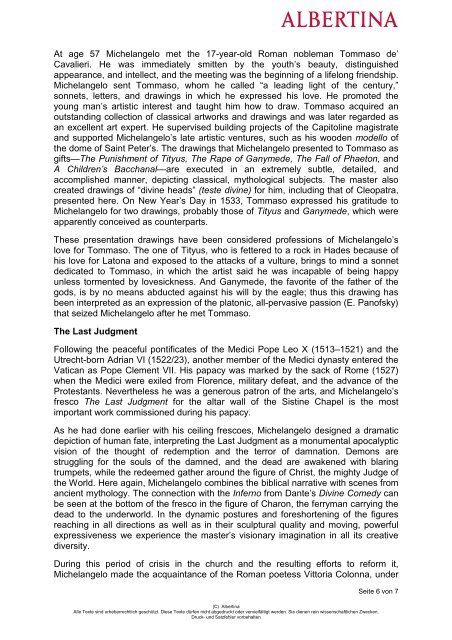Michelangelo. The drawings of a genius - Freizeitbetriebe-wien.at
Michelangelo. The drawings of a genius - Freizeitbetriebe-wien.at
Michelangelo. The drawings of a genius - Freizeitbetriebe-wien.at
You also want an ePaper? Increase the reach of your titles
YUMPU automatically turns print PDFs into web optimized ePapers that Google loves.
At age 57 <strong>Michelangelo</strong> met the 17-year-old Roman nobleman Tommaso de’<br />
Cavalieri. He was immedi<strong>at</strong>ely smitten by the youth’s beauty, distinguished<br />
appearance, and intellect, and the meeting was the beginning <strong>of</strong> a lifelong friendship.<br />
<strong>Michelangelo</strong> sent Tommaso, whom he called “a leading light <strong>of</strong> the century,”<br />
sonnets, letters, and <strong>drawings</strong> in which he expressed his love. He promoted the<br />
young man’s artistic interest and taught him how to draw. Tommaso acquired an<br />
outstanding collection <strong>of</strong> classical artworks and <strong>drawings</strong> and was l<strong>at</strong>er regarded as<br />
an excellent art expert. He supervised building projects <strong>of</strong> the Capitoline magistr<strong>at</strong>e<br />
and supported <strong>Michelangelo</strong>’s l<strong>at</strong>e artistic ventures, such as his wooden modello <strong>of</strong><br />
the dome <strong>of</strong> Saint Peter’s. <strong>The</strong> <strong>drawings</strong> th<strong>at</strong> <strong>Michelangelo</strong> presented to Tommaso as<br />
gifts—<strong>The</strong> Punishment <strong>of</strong> Tityus, <strong>The</strong> Rape <strong>of</strong> Ganymede, <strong>The</strong> Fall <strong>of</strong> Phaeton, and<br />
A Children’s Bacchanal—are executed in an extremely subtle, detailed, and<br />
accomplished manner, depicting classical, mythological subjects. <strong>The</strong> master also<br />
cre<strong>at</strong>ed <strong>drawings</strong> <strong>of</strong> “divine heads” (teste divine) for him, including th<strong>at</strong> <strong>of</strong> Cleop<strong>at</strong>ra,<br />
presented here. On New Year’s Day in 1533, Tommaso expressed his gr<strong>at</strong>itude to<br />
<strong>Michelangelo</strong> for two <strong>drawings</strong>, probably those <strong>of</strong> Tityus and Ganymede, which were<br />
apparently conceived as counterparts.<br />
<strong>The</strong>se present<strong>at</strong>ion <strong>drawings</strong> have been considered pr<strong>of</strong>essions <strong>of</strong> <strong>Michelangelo</strong>’s<br />
love for Tommaso. <strong>The</strong> one <strong>of</strong> Tityus, who is fettered to a rock in Hades because <strong>of</strong><br />
his love for L<strong>at</strong>ona and exposed to the <strong>at</strong>tacks <strong>of</strong> a vulture, brings to mind a sonnet<br />
dedic<strong>at</strong>ed to Tommaso, in which the artist said he was incapable <strong>of</strong> being happy<br />
unless tormented by lovesickness. And Ganymede, the favorite <strong>of</strong> the f<strong>at</strong>her <strong>of</strong> the<br />
gods, is by no means abducted against his will by the eagle; thus this drawing has<br />
been interpreted as an expression <strong>of</strong> the pl<strong>at</strong>onic, all-pervasive passion (E. Pan<strong>of</strong>sky)<br />
th<strong>at</strong> seized <strong>Michelangelo</strong> after he met Tommaso.<br />
<strong>The</strong> Last Judgment<br />
Following the peaceful pontific<strong>at</strong>es <strong>of</strong> the Medici Pope Leo X (1513–1521) and the<br />
Utrecht-born Adrian VI (1522/23), another member <strong>of</strong> the Medici dynasty entered the<br />
V<strong>at</strong>ican as Pope Clement VII. His papacy was marked by the sack <strong>of</strong> Rome (1527)<br />
when the Medici were exiled from Florence, military defe<strong>at</strong>, and the advance <strong>of</strong> the<br />
Protestants. Nevertheless he was a generous p<strong>at</strong>ron <strong>of</strong> the arts, and <strong>Michelangelo</strong>’s<br />
fresco <strong>The</strong> Last Judgment for the altar wall <strong>of</strong> the Sistine Chapel is the most<br />
important work commissioned during his papacy.<br />
As he had done earlier with his ceiling frescoes, <strong>Michelangelo</strong> designed a dram<strong>at</strong>ic<br />
depiction <strong>of</strong> human f<strong>at</strong>e, interpreting the Last Judgment as a monumental apocalyptic<br />
vision <strong>of</strong> the thought <strong>of</strong> redemption and the terror <strong>of</strong> damn<strong>at</strong>ion. Demons are<br />
struggling for the souls <strong>of</strong> the damned, and the dead are awakened with blaring<br />
trumpets, while the redeemed g<strong>at</strong>her around the figure <strong>of</strong> Christ, the mighty Judge <strong>of</strong><br />
the World. Here again, <strong>Michelangelo</strong> combines the biblical narr<strong>at</strong>ive with scenes from<br />
ancient mythology. <strong>The</strong> connection with the Inferno from Dante’s Divine Comedy can<br />
be seen <strong>at</strong> the bottom <strong>of</strong> the fresco in the figure <strong>of</strong> Charon, the ferryman carrying the<br />
dead to the underworld. In the dynamic postures and foreshortening <strong>of</strong> the figures<br />
reaching in all directions as well as in their sculptural quality and moving, powerful<br />
expressiveness we experience the master’s visionary imagin<strong>at</strong>ion in all its cre<strong>at</strong>ive<br />
diversity.<br />
During this period <strong>of</strong> crisis in the church and the resulting efforts to reform it,<br />
<strong>Michelangelo</strong> made the acquaintance <strong>of</strong> the Roman poetess Vittoria Colonna, under<br />
Seite 6 von 7<br />
(C) Albertina<br />
Alle Texte sind urheberrechtlich geschützt. Diese Texte dürfen nicht abgedruckt oder vervielfältigt werden. Sie dienen rein wissenschaftlichen Zwecken.<br />
Druck- und S<strong>at</strong>zfehler vorbehalten
















